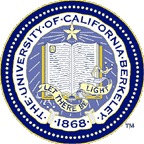Electromagnetic field and Joule heating
Evolution of electric field intensity E, magnetic field intensity H and temperature over a randomly generated representative volume element (RVE) of a test material is computed by simultaneously solving dynamic Maxwell’s equations using Yee’s scheme and heat equation using Forward Euler scheme. Below are some sample simulations. RVE http://cmrl.berkeley.edu/wp-content/uploads/Bhavesh_Ex_field.mp4 Ex field over a cross-section http://cmrl.berkeley.edu/wp-content/uploads/Bhavesh_Hx_field.mp4 Hx field over a cross-section http://cmrl.berkeley.edu/wp-content/uploads/Bhavesh_temp.mp4 Temperature over a cross-section More details...
Read MoreBeam Based Modeling
http://cmrl.berkeley.edu/wp-content/uploads/Long_time_lapse_center.mp4 http://cmrl.berkeley.edu/wp-content/uploads/time_dep.mp4...
Read MoreSLS/ SLM process
Single pass of a laser beam over a pre-deposited layer of steel powder particles. In this simulation DEM particles are placed on top of the solid, underneath substrate, which is modeled via the finite difference method (FDM). Particles colored red indicate that they have melted. http://cmrl.berkeley.edu/wp-content/uploads/Rishi_DEM-FDM.mp4 Side view of the same simulation. Notice how part of the underneath substrate layer is also melted (in addition to the particles). This is desirable to ensure proper bonding between layers during the SLS/ SLM process. http://cmrl.berkeley.edu/wp-content/uploads/Rishi_DEM-FDM_side.mp4...
Read MoreDeposition and Laser Heating
Deposition and subsequent laser heating of a layer of metal, powder particles using the discrete element method (DEM). Each individual particle is assumed to be spherical in shape and to have a homogenous temperature. http://cmrl.berkeley.edu/wp-content/uploads/RishiSLSVideo.mp4...
Read MoreAblation
Shown in the videos are simulations laser ablation of inks with three phases to model the solvent(blue), the nano-particles(gold) and the ligands(white) used to prevent premature clumping during production. The videos show the results of simulations using two heat source shapes, a line and cross. It is shown that from random isotropically placed nano-particles the desired linear shape can be made and cross shapes can be produced when correct amounts of heating are applied. As additional heating is applied, the cross continues to flow into a uniform clump....
Read MoreColliding and Flowing Particles
Shown in the video is a stream of particles impacting a surface. The viewer can see there are many particle interactions taking place such as agglomeration. ...
Read MoreImpact Test
This video shows what it commonly termed an impact test. A ball penetrates this coating to show how the material fails. The material is simulated by many particles....
Read MoreBullet Impact on Ballistic Fabric
Shown in the video is a simulation of a bullet hitting a ballistic fabric. On the right hand side, the bullet hits a fabric that is not charged. On the left hand side, the situation of the bullet hitting an electro-magnetically charged fabric. It is shown that the bullet changes orientation from pointing straight ahead to on its side. ...
Read More
